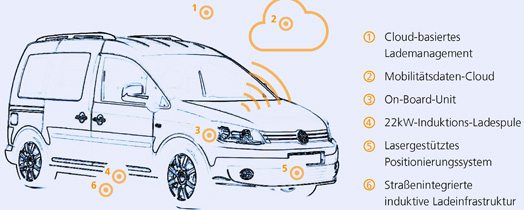E-car sharing comes of age

GeMo © Fraunhofer IAO
But if it’s going to succeed with electric vehicles, charging times need to be shorter and booking processes simpler. That means a straightforward process for finding the electric car that best suits your needs as well as a wide-ranging charging infrastructure. At the eCarTec trade fair in Munich on October 22, six Fraunhofer Institutes will be demonstrating the technology that will make e car sharing a viable concept.
Every day, private motor transportation causes traffic jams, pollution and a shortage of parking spaces. The number one mode of transportation – the automobile – is one of the biggest burdens on urban spaces and their inhabitants. But does it have to be this way?
Other options have emerged that offer reliable, low-emission mobility in cities and the surrounding areas: not just electromobility, but digital networking and car sharing, too. In a project entitled “Shared use of e-mobility: vehicles, data and infrastructure” (GeMo for short), six Fraunhofer Institutes are combining these trends, which so far have been worked on virtually in isolation, and making them accessible.
The result: a comprehensive package of eight technological innovations that are making shared e-vehicles the true superheroes of the city. To better demonstrate these advances, the institutes have bundled them in a concept car. With access to a pioneering infrastructure featuring inductive charging stations and cloud-based charging management, charging the e-car becomes fast and straightforward.
What’s more, if it’s a car sharing vehicle, drivers can easily find it in the city and book it using a convenient app. An on-board unit enables the car to communicate with various cloud services, other e vehicles and the charging infrastructure. As a result, the car can provide data on its position, or how much charge its battery has remaining.
“To make shared mobility a reality, we have to link vehicles, data and infrastructure. That was the core of our project,” says Florian Rothfuss, the person in charge of the GeMo project at consortium leader Fraunhofer IAO. “What we need are applicable information and communication solutions that are both very reliable and easy to use. However, everything depends on having a convenient charging infrastructure integrated within the city.”
The six Fraunhofer Institutes will reveal their solutions on October 22 at eCarTec in Munich (Booth 418). Naturally, visitors will have the chance to take a close look at the concept car and get information about the new technologies straight from the developers. Experts from automotive manufacturing as well as urban and project development will also be on hand to discuss the future of mobility.
Working on the GeMo project are researchers from the Fraunhofer Institutes for Embedded Systems and Communication Technologies ESK in Munich, for Open Communication Systems FOKUS in Berlin, for Industrial Engineering IAO in Stuttgart, for Integrated Circuits IIS in Erlangen, for Solar Energy Systems ISE in Freiburg as well as for Transportation and Infrastructure Systems IVI in Dresden.
The latest innovations in detail:
• An inductive, bidirectional charging system with 22 kilowatts of power and up to 95 percent efficiency from grid to battery ensures rapid charging.
• Using a laser scanner, the driver can position the car precisely over the inductive charging station.
• The latter has all of the charging components integrated in an underground shaft, keeping it concealed from view.
• Cloud-based charging management optimizes the charging processes for multiple shared e-cars.
• An on-board unit ensures seamless communication between vehicles in the car sharing fleet.
• Cloud-based mobility services make it possible for users to register, personalize their profiles, book a car or charging station and receive invoices for usage – all with a convenient app.
• A cloud collects mobility-relevant data over an internet connection, provides that data to other services and consequently links the various subsystems.
• Cars are localized seamlessly, even in parking garages and underground parking lots, thanks to a combination of a Wi-Fi positioning system, GPS, inertial sensors and movement models (awiloc®). This means users can easily locate available vehicles.
Contact
Florian Rothfuss
Mobility and Urban Systems Engineering
Fraunhofer IAO
Nobelstraße 12
70569 Stuttgart, Germany
Phone +49 711 970-2091
E-Mail: florian.rothfuss@iao.fraunhofer.de
http://www.gemo.fraunhofer.de/en
http://www.iao.fraunhofer.de/vk250.html
Media Contact
All latest news from the category: Information Technology
Here you can find a summary of innovations in the fields of information and data processing and up-to-date developments on IT equipment and hardware.
This area covers topics such as IT services, IT architectures, IT management and telecommunications.
Newest articles

Superradiant atoms could push the boundaries of how precisely time can be measured
Superradiant atoms can help us measure time more precisely than ever. In a new study, researchers from the University of Copenhagen present a new method for measuring the time interval,…

Ion thermoelectric conversion devices for near room temperature
The electrode sheet of the thermoelectric device consists of ionic hydrogel, which is sandwiched between the electrodes to form, and the Prussian blue on the electrode undergoes a redox reaction…

Zap Energy achieves 37-million-degree temperatures in a compact device
New publication reports record electron temperatures for a small-scale, sheared-flow-stabilized Z-pinch fusion device. In the nine decades since humans first produced fusion reactions, only a few fusion technologies have demonstrated…





















